|
|
|
Sort Order |
|
|
|
Items / Page
|
|
|
|
|
|
|
| Srl | Item |
| 1 |
ID:
062067
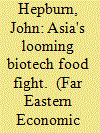

|
|
|
| 2 |
ID:
090967
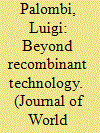

|
|
|
|
|
| Publication |
2009.
|
| Summary/Abstract |
Even though it is not yet clear as a matter of law that isolated biological materials are indeed patentable subject matter, patents over such materials continue to be granted throughout the world. Recently, Craig Venter, the man who wanted to patent the human genome, made history again. This time he has built a synthetic bacterium from the ground up-in a laboratory. The bacterium, Mycoplasma genitalium, is a naturally occurring thing. It is the smallest known bacterium consisting of 582,970 nucleotides. Venter's version of this bacterium is identical, except that he made it. Does this make it an invention? Indeed, Venter has in mind to use this synthetic bacterium, and other synthetic biological materials, as plasmids within which to insert genetic material that is foreign to that organism. The idea is to use these plasmids to manufacture other biological materials. It is a repeat of Cohen and Boyer's idea, which they also patented, but this time the plasmid itself will be a human construct. Is the patent system ready for Venter and his "invention"?
|
|
|
|
|
|
|
|
|
|
|
|
|
|
|
|
| 3 |
ID:
183589
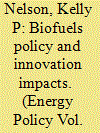

|
|
|
|
|
| Summary/Abstract |
In the early 2000s, governments implemented policies stimulating the use of ethanol and biodiesel to reduce carbon emissions and encourage domestic energy production. Blend mandates requiring gasoline or diesel to contain a minimum percentage of these biofuels were a favored policy instrument. Theoretical work by Clancy and Moschini (2017) concluded that, if innovation were stimulated by mandates, then the socially optimal mandate would be higher than if innovation were not possible. We test the impact of blend mandates and other biofuels policies on innovation using measures of patenting activity that correspond with research effort and research output. Our analysis shows that ethanol blend mandates significantly increased both R&D effort and quality-weighted innovation output in biofuels technologies while reducing the R&D inputs to plant technologies. This suggests that biofuels innovation increased in response to the policies, with firms substituting some R&D effort away from plant technologies research. Despite decreased R&D effort, output of plant innovation held steady as effort shifted to biofuels, supporting the presence of a spillover effect between biofuels innovation and plant innovation. We find that biodiesel blend mandates did not significantly impact R&D efforts in either plant or biofuels technologies. Furthermore, policies other than blend mandates had varying effects, ranging from limited increases in R&D activity to significant decreases in innovation.
|
|
|
|
|
|
|
|
|
|
|
|
|
|
|
|
| 4 |
ID:
124636
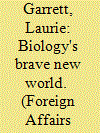

|
|
|
|
|
| Publication |
2013.
|
| Summary/Abstract |
In May 2010, the richest, most powerful man in biotechnology made a new creature. J. Craig Venter and his private-company team started with DNA and constructed a novel genetic sequence of more than one million coded bits of information known as nucleotides. Seven years earlier, Venter had been the first person in history to make a functioning creature from information. Looking at the strings of letters representing the DNA sequence for a virus called phi X174, which infects bacteria, he thought to himself, "I can assemble real DNA based on that computer information." And so he did, creating a virus based on the phi X174 genomic code. He followed the same recipe later on to generate the DNA for his larger and more sophisticated creature. Venter and his team figured out how to make an artificial bacterial cell, inserted their man-made DNA genome inside, and watched as the organic life form they had synthesized moved, ate, breathed, and replicated itself.
|
|
|
|
|
|
|
|
|
|
|
|
|
|
|
|
| 5 |
ID:
056835
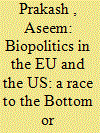

|
|
|
| 6 |
ID:
050510
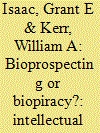

|
|
|
| 7 |
ID:
072381
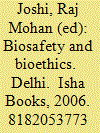

|
|
|
|
|
| Publication |
DelhI, Isha Books, 2006.
|
| Description |
271p.Hbk
|
| Standard Number |
8182053773
|
|
|
|
|
|
|
|
|
|
|
|
Copies: C:1/I:0,R:0,Q:0
Circulation
| Accession# | Call# | Current Location | Status | Policy | Location |
| 051334 | 660.6/JOS 051334 | Main | On Shelf | General | |
|
|
|
|
| 8 |
ID:
021670
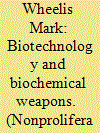

|
|
|
|
|
| Publication |
Spring 2002.
|
| Description |
48-53
|
|
|
|
|
|
|
|
|
|
|
|
|
|
|
|
| 9 |
ID:
087990


|
|
|
|
|
| Publication |
2009.
|
| Summary/Abstract |
Throughout military history, some changes in technology have provided new weapons and capabilities to military commanders. Some of those changes were so significant, as in the case of nuclear weapons, that they modified the strategic positions of the countries that possessed them within the international system. Although biological weapons cannot destroy civilian or military infrastructure, they can kill people in large numbers. Because the effects of the dissemination of biological weapons are invisible, delayed, and uncertain, genetically modified biological weapons can acquire a deterrence capability that would present serious challenges to United States policymakers.
|
|
|
|
|
|
|
|
|
|
|
|
|
|
|
|
| 10 |
ID:
052433
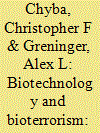

|
|
|
|
|
| Publication |
2004.
|
| Description |
p143-161
|
| Summary/Abstract |
The web of measures that comprise the nuclear non-proliferation regime continues to hold at bay the 'nuclear-armed crowd' that was part of President John F. Kennedy's alarming vision in 1963. The number of nuclear weapons states in 2004 stands at only eight or nine, and assertive steps may yet keep this number from growing. The proliferation of biological weapons, however, is quite another matter. Biotechnological capacity is increasing and spreading rapidly. This trend seems unstoppable, since the economic, medical and food-security benefits of genetic manipulation appear so great. As a consequence, thresholds for the artificial enhancement or creation of dangerous pathogens - disease causing organisms - will steadily drop. Neither Cold War bilateral arms control nor multilateral non-proliferation provide good models for how we are to manage this new challenge. Much more than in the nuclear case, civilisation will have to cope with, rather than shape, its biological future.
|
|
|
|
|
|
|
|
|
|
|
|
|
|
|
|
| 11 |
ID:
021936
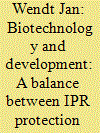

|
|
|
|
|
| Publication |
May 2002.
|
| Description |
233-240
|
|
|
|
|
|
|
|
|
|
|
|
|
|
|
|
| 12 |
ID:
130300


|
|
|
|
|
| Publication |
2014.
|
| Summary/Abstract |
Genetically engineered (GE) foods apply new molecular technologies to agriculture. Widely adopted in the United States, Brazil and Argentina for the production of cons, soybeans, and cotton, they are practically banned in Europe and tightly regulated throughout the world. We have found that GE foods have significantly increase supplies cons, soybeans, and cotton, and lowered their prices, Thus improving food security, GE foods have already contributed to a reductions in the use of pesticides and emissions of greenhouse gases.
|
|
|
|
|
|
|
|
|
|
|
|
|
|
|
|
| 13 |
ID:
074540
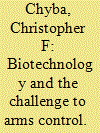

|
|
|
| 14 |
ID:
004922
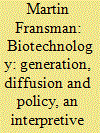

|
|
|
|
|
| Publication |
Maastricht, UNs Univ., 1992.
|
| Description |
v,93p.;figures
|
| Series |
UNU/INTECH working paper;1
|
|
|
|
|
|
|
|
|
|
|
|
Copies: C:1/I:0,R:0,Q:0
Circulation
| Accession# | Call# | Current Location | Status | Policy | Location |
| 035944 | 660.6/FRA 035944 | Main | Withdrawn | General | |
|
|
|
|
| 15 |
ID:
007267
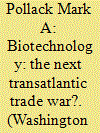

|
|
|
|
|
| Publication |
Autumn 2000.
|
| Description |
41-54
|
|
|
|
|
|
|
|
|
|
|
|
|
|
|
|
| 16 |
ID:
095975
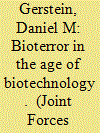

|
|
|
| 17 |
ID:
093389
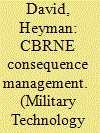

|
|
|
| 18 |
ID:
113095
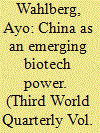

|
|
|
|
|
| Publication |
2012.
|
| Summary/Abstract |
Asia's dramatic entry on to the global biotech scene has not gone unnoticed by commentators and social scientists. Countries like China, India, South Korea and Singapore have been identified as 'emerging biotech powers'. Consequently scholars have begun examining the particularities of how biotechnologies (eg stem cell science, genetic testing and reproductive medicine) have come to be taken up and grounded in a variety of cultural, legal and socioeconomic contexts. They have also examined how governments, scientists, clinicians and others have been engaged in efforts to build up endogenous biotech sectors as a part of nation-building strategies. In this article, rather than attempting to answer questions of what makes biotechnology particularly Asian, I will instead investigate how demarcations and boundaries are mooted in global negotiations of what constitutes 'good' biotechnology. The analysis is based on a collaborative project between Chinese and European scientists and experts on the ethical governance of biomedical and biological research. I show how an underlying condition for the negotiations that took place within this collaboration was the proposition that difference matters when it comes to developing, organising, carrying out and overseeing biotechnological research in a particular country.
|
|
|
|
|
|
|
|
|
|
|
|
|
|
|
|
| 19 |
ID:
129700
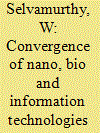

|
|
|
| 20 |
ID:
171463
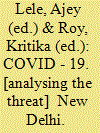

|
|
|
|
|
| Publication |
New Delhi, Pentagon Press, 2020.
|
| Description |
xxvii, 426p.hbk
|
| Standard Number |
9789390095070
|
|
|
|
|
|
|
|
|
|
|
|
Copies: C:1/I:0,R:0,Q:0
Circulation
| Accession# | Call# | Current Location | Status | Policy | Location |
| 059874 | 303.485/LEL 059874 | Main | On Shelf | General | |
|
|
|
|
|
|
|
|
|